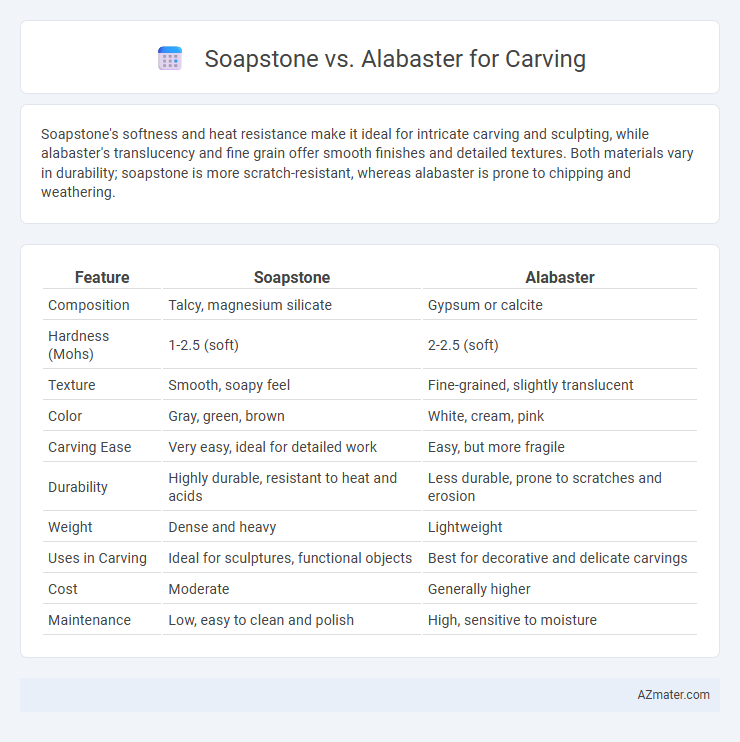Soapstone's softness and heat resistance make it ideal for intricate carving and sculpting, while alabaster's translucency and fine grain offer smooth finishes and detailed textures. Both materials vary in durability; soapstone is more scratch-resistant, whereas alabaster is prone to chipping and weathering.
Table of Comparison
| Feature | Soapstone | Alabaster |
|---|---|---|
| Composition | Talcy, magnesium silicate | Gypsum or calcite |
| Hardness (Mohs) | 1-2.5 (soft) | 2-2.5 (soft) |
| Texture | Smooth, soapy feel | Fine-grained, slightly translucent |
| Color | Gray, green, brown | White, cream, pink |
| Carving Ease | Very easy, ideal for detailed work | Easy, but more fragile |
| Durability | Highly durable, resistant to heat and acids | Less durable, prone to scratches and erosion |
| Weight | Dense and heavy | Lightweight |
| Uses in Carving | Ideal for sculptures, functional objects | Best for decorative and delicate carvings |
| Cost | Moderate | Generally higher |
| Maintenance | Low, easy to clean and polish | High, sensitive to moisture |
Introduction: Understanding Soapstone and Alabaster
Soapstone and alabaster are popular materials for carving due to their softness and workability, but they differ significantly in composition and characteristics. Soapstone is a talc-rich metamorphic rock known for its smooth texture, durability, and heat resistance, making it ideal for intricate sculptures and functional objects. Alabaster, a form of gypsum or calcite, features a translucent quality and fine grain, prized for its delicate aesthetic but softer nature that requires careful handling.
Key Characteristics of Soapstone
Soapstone is favored for carving due to its softness, ranging from 1 to 2.5 on the Mohs hardness scale, which allows for easy shaping and intricate detailing. Its high talc content gives it a smooth, soapy texture and excellent heat resistance, making it suitable for both artistic sculptures and functional items like countertops. Soapstone's durability and natural resistance to acids and stains make it a versatile material compared to more brittle stones like alabaster.
Key Characteristics of Alabaster
Alabaster is a soft, fine-grained mineral composed primarily of gypsum or calcite, prized for its smooth texture and translucence ideal for detailed carving and delicate sculptures. Its low hardness, typically around 1.5 to 2 on the Mohs scale, allows for ease of shaping but requires careful handling to avoid damage. Alabaster's warm, creamy tones and ability to diffuse light make it favored in decorative art and interior accents compared to the denser, more durable soapstone.
Workability and Carving Ease
Soapstone is renowned for its exceptional workability due to its softness and smooth texture, making it ideal for beginners and detailed carving projects. Alabaster, although softer than many stones, can be more brittle and prone to chipping, requiring more careful handling during carving. The ease of carving soapstone allows for intricate designs with less effort, while alabaster offers a slightly harder surface that demands precision but rewards with a translucent finish.
Durability and Longevity
Soapstone offers superior durability for carving projects due to its dense, non-porous structure, making it highly resistant to scratches, weathering, and erosion. Alabaster, while favored for its smooth texture and translucent appearance, is much softer and more prone to damage, requiring careful handling and indoor display to ensure longevity. Choosing soapstone guarantees longer-lasting sculptures and carvings, especially for outdoor or high-contact applications.
Finishing and Surface Appearance
Soapstone offers a smooth, matte finish with a naturally soft, waxy texture that enhances detailed carving and polishes to a gentle sheen, making it ideal for tactile art pieces. Alabaster provides a translucent, luminous surface that takes on a glossy finish when polished, highlighting its fine grain and subtle color variations, which suits sculptures meant to capture light and shadow. Both stones respond well to sanding and polishing, but alabaster's delicate structure requires careful handling to avoid chipping while achieving a pristine surface.
Cost Comparison: Soapstone vs. Alabaster
Soapstone generally costs less than alabaster, making it a more budget-friendly option for carvers seeking affordability without sacrificing workability. Alabaster, valued for its translucent quality and finer grain, typically commands a higher price due to its aesthetic appeal and limited availability. The cost difference between soapstone and alabaster varies based on factors like size, quality, and region, but soapstone remains the preferred choice for cost-conscious artists.
Ideal Uses for Soapstone in Carving
Soapstone is favored for carving due to its softness, ease of shaping, and heat resistance, making it ideal for detailed sculptures, cookware, and fireplaces. Its non-porous nature allows for smooth finishes and durability, especially suited for intricate decorative items and functional kitchenware like mortar and pestles. Soapstone's ability to withstand temperature changes without cracking enhances its suitability for both artistic and practical carving projects.
Ideal Uses for Alabaster in Carving
Alabaster is ideal for intricate indoor carvings due to its smooth texture and fine grain, which allow for detailed, delicate work. Its softness makes it suitable for small sculptures, decorative objects, and ornamental pieces that require precision rather than durability. Unlike soapstone, alabaster is more prone to damage from moisture, making it best for protected environments and purely artistic applications.
Choosing the Right Stone for Your Project
Soapstone offers superior durability and heat resistance, making it ideal for detailed figurines and kitchenware, while alabaster's softness and translucency suit delicate sculptures and decorative pieces where fine detail and light diffusion matter. Consider the project's purpose and environment: soapstone withstands outdoor conditions better, whereas alabaster requires indoor display due to its susceptibility to moisture and damage. Selecting the right stone hinges on balancing hardness, carving ease, and the final aesthetic effect desired.

Infographic: Soapstone vs Alabaster for Carving
 azmater.com
azmater.com